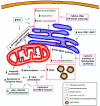Impact of Drosophila Models in the Study and Treatment of Friedreich's Ataxia
- PMID: 29986523
- PMCID: PMC6073496
- DOI: 10.3390/ijms19071989
Impact of Drosophila Models in the Study and Treatment of Friedreich's Ataxia
Abstract
Drosophila melanogaster has been for over a century the model of choice of several neurobiologists to decipher the formation and development of the nervous system as well as to mirror the pathophysiological conditions of many human neurodegenerative diseases. The rare disease Friedreich’s ataxia (FRDA) is not an exception. Since the isolation of the responsible gene more than two decades ago, the analysis of the fly orthologue has proven to be an excellent avenue to understand the development and progression of the disease, to unravel pivotal mechanisms underpinning the pathology and to identify genes and molecules that might well be either disease biomarkers or promising targets for therapeutic interventions. In this review, we aim to summarize the collection of findings provided by the Drosophila models but also to go one step beyond and propose the implications of these discoveries for the study and cure of this disorder. We will present the physiological, cellular and molecular phenotypes described in the fly, highlighting those that have given insight into the pathology and we will show how the ability of Drosophila to perform genetic and pharmacological screens has provided valuable information that is not easily within reach of other cellular or mammalian models.
Keywords: Drosophila melanogaster; Friedreich’s ataxia; drug screens; endoplasmic reticulum; frataxin; genetic screens; iron; lipid metabolism; metal homeostasis; oxidative stress.
Conflict of interest statement
The authors declare no conflict of interest.
Figures




Similar articles
-
Drosophila melanogaster Models of Friedreich's Ataxia.Biomed Res Int. 2018 Apr 5;2018:5065190. doi: 10.1155/2018/5065190. eCollection 2018. Biomed Res Int. 2018. PMID: 29850527 Free PMC article. Review.
-
Methylene blue rescues heart defects in a Drosophila model of Friedreich's ataxia.Hum Mol Genet. 2014 Feb 15;23(4):968-79. doi: 10.1093/hmg/ddt493. Epub 2013 Oct 8. Hum Mol Genet. 2014. PMID: 24105471
-
Deferiprone and idebenone rescue frataxin depletion phenotypes in a Drosophila model of Friedreich's ataxia.Gene. 2013 Jun 1;521(2):274-81. doi: 10.1016/j.gene.2013.02.049. Epub 2013 Mar 28. Gene. 2013. PMID: 23542074
-
Drug repositioning screening identifies etravirine as a potential therapeutic for friedreich's ataxia.Mov Disord. 2019 Mar;34(3):323-334. doi: 10.1002/mds.27604. Epub 2019 Jan 9. Mov Disord. 2019. PMID: 30624801
-
The role of oxidative stress in Friedreich's ataxia.FEBS Lett. 2018 Mar;592(5):718-727. doi: 10.1002/1873-3468.12928. Epub 2017 Dec 20. FEBS Lett. 2018. PMID: 29197070 Free PMC article. Review.
Cited by
-
The Role of Iron in Friedreich's Ataxia: Insights From Studies in Human Tissues and Cellular and Animal Models.Front Neurosci. 2019 Feb 18;13:75. doi: 10.3389/fnins.2019.00075. eCollection 2019. Front Neurosci. 2019. PMID: 30833885 Free PMC article. Review.
-
Oxidative stress modulates rearrangement of endoplasmic reticulum-mitochondria contacts and calcium dysregulation in a Friedreich's ataxia model.Redox Biol. 2020 Oct;37:101762. doi: 10.1016/j.redox.2020.101762. Epub 2020 Oct 16. Redox Biol. 2020. PMID: 33128998 Free PMC article.
-
Evolution of an Iron-Detoxifying Protein: Eukaryotic and Rickettsia Frataxins Contain a Conserved Site Which Is Not Present in Their Bacterial Homologues.Int J Mol Sci. 2022 Oct 29;23(21):13151. doi: 10.3390/ijms232113151. Int J Mol Sci. 2022. PMID: 36361939 Free PMC article.
-
Drug screening in Drosophila; why, when, and when not?Wiley Interdiscip Rev Dev Biol. 2019 Nov;8(6):e346. doi: 10.1002/wdev.346. Epub 2019 May 5. Wiley Interdiscip Rev Dev Biol. 2019. PMID: 31056843 Free PMC article. Review.
-
Perspectives on current models of Friedreich's ataxia.Front Cell Dev Biol. 2022 Aug 11;10:958398. doi: 10.3389/fcell.2022.958398. eCollection 2022. Front Cell Dev Biol. 2022. PMID: 36036008 Free PMC article.
References
-
- Cnop M., Igoillo-Esteve M., Rai M., Begu A., Serroukh Y., Depondt C., Musuaya A.E., Marhfour I., Ladrière L., Moles Lopez X., et al. Central role and mechanisms of β-cell dysfunction and death in friedreich ataxia-associated diabetes. Ann. Neurol. 2012;72:971–982. doi: 10.1002/ana.23698. - DOI - PMC - PubMed
-
- Campuzano V., Montermini L., Moltò M.D., Pianese L., Cossée M., Cavalcanti F., Monros E., Rodius F., Duclos F., Monticelli A., et al. Friedreich’s ataxia: Autosomal recessive disease caused by an intronic GAA triplet repeat expansion. Science. 1996;271:1423–1427. doi: 10.1126/science.271.5254.1423. - DOI - PubMed
Publication types
MeSH terms
Substances
LinkOut - more resources
Full Text Sources
Other Literature Sources
Medical
Molecular Biology Databases

